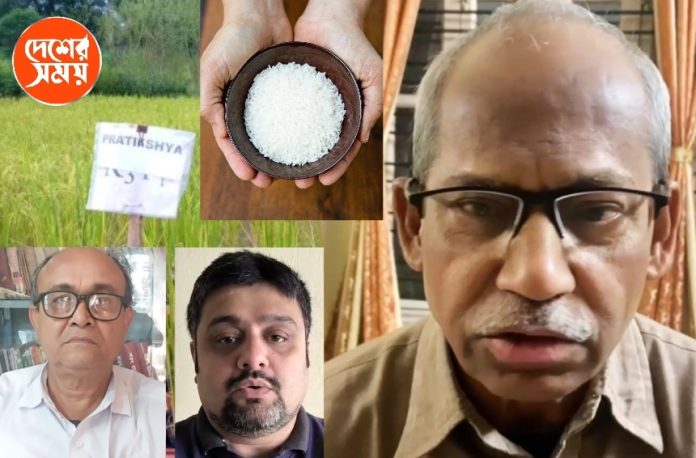
A panel of Bengali Agronomists claimed that the rice or bread that we regularly consume is not filled with the essential nutrients rather, the rice and wheat grains contains several toxic substances that cannot be removed even after several stages of refinement when these toxic substances are consumed along with the staples regularly, leads to several non-communicable and fatal diseases.

Bishwapati Mandal, an agronomist at Bidhan Chandra Krishi Vidyalaya. Mohanpur said that the nutritional quality of rice and wheat, which was present during the 1960s, has disappeared since 2000s. And now the nutritional elements are less and toxic elements are present in abundance. The nutritional levels in the paddy and wheat have significantly dropped by 45% since 1960s. “So the kind of rice and bread that our fathers and grandfathers consumed was much more nutritious, but the food the present generation is consuming is poisonous for the body.” Watch the Video
Indian council of agriculture research (ICAR) has given a report on this said from 2010, the concentrations of Essential elements including calcium, iron and Zinc has been found to be extremely low in rice or wheat. Calcium is needed for bone health iron for hemoglobin and Zinc is used to boost the body’s immune system. If foods are consumed with low nutritional levels there will be no benefit.
According to the research of Bengali scientists, the calcium levels in wheat were cultivated in 2010 are 30 percent less than 50 years ago, iron and zinc contents are 19 and 27 percent less respectively. Experts are afraid that low levels of these essential minerals can have adverse health effects. Because calcium is important for bone formation iron for hemoglobin and Zinc for reproductive and neurological health.
Rice contains about 16 times more arsenic and four times more chromium than in the 1960s. The arsenic is spread all over the rice and wheat items. Arsenic – laced groundwater when used in farming, then the crops become even more poisonous. After the Green Revolution several Chemicals were recommended to be applied in order to increase the yields, although it inflated the bowels of many , but it sacrificed the nutritional value. According to the Standard Set by the World Health Organization, 2 micrograms of arsenic per kilogram of body weight is considered as normal for an adult. On the alongside, when the samples were collected it was found that on an average, 150 micrograms of arsenic were present per kilogram of rice.
In some samples of rice arsenic was present in a minimum of 94 micrograms and maximum of 162 micrograms per kg. 86 micrograms of arsenic per kg were found in wheat. Among the various forms of arsenic the most dangerous is the “arsenic – 3” commonly known as the Arsenide. The arsenide is commonly found in most of the rice and wheat that are sold in the markets today. Arsenide is the main cause of several heart, kidney complex lung diseases and various types of cancer. Parts of hands and feet may rot. Infections can also occur in our nervous system.
Scientists are even looking at the possibility that when these food items are consumed with these toxic ingredients, it also leads to various neurological diseases.
What happened in the past five decades, that there was a huge decline in the nutritional quality of the rice & wheat in the country?

According to Sovan Debnath, Agriculture scientist that the aim of the Green Revolution was to produce hybrid crops. These species of crops had high crop yield as well as well resistance to pests, as a result the country became self-sufficient in food but the nutritional quality has been greatly sacrificed.
Professor Abhijeet Nandi of Agriculture University said, “hybrid variety doesn’t have Double fertility. So while breeding we have to ponder how to maintain the nutritional value.”
Sanchita Seal, Nutritionist have said, “brown rice is very popular and it contains much more minerals than other types of rice”.

Asok Das, please secretary of arsenic pollution prevention committee stated lately a think tank of experts have seen that arsenic goes into our body after consuming several food items like, rise wheat and its products. This leads to several harmful health consequences.
In Ghaighata block, North 24 Pargana, many people have lost their lives because of this arsenic contamination. Many Bengali researchers of the Central Agricultural Research Organisation have raised the concern that another green revolution is necessary in our country in order to prevent this danger.

Dr. Sayak Ganguli, Assistant Professor at St. Xavier’s College, Kolkata said, ” arsenic toxicity is primarily caused by groundwater contamination, also by cultivating the crops in those areas where the soil is highly contaminated. Prolonged injection of arsenic above the safe doses for at least above 6 months leads to a chronic health condition known as arsenicosis . Symptoms arsenicosis are, dark skin patches, persistent digestive issues, hepatic problems can also occur due to the prolonged exposure of arsenic. This condition can be prevented by cultivating the crops in those areas, which has not yet been contaminated by this deadly poison also some bacteria can be grown in those contaminated fields which can remove this deadly poison.”
Thus the government must take some measures along with the fore coming researchers, while discovering the new varieties of crops about how to prevent this contamination of the arsenic.




